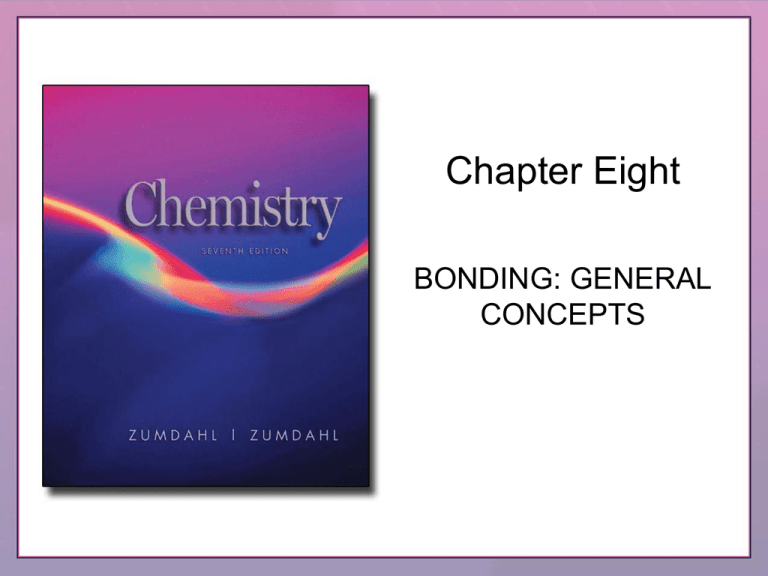
Chapter Eight
BONDING: GENERAL
CONCEPTS
Questions to Consider
•
•
•
What is meant by the term “chemical
bond?”
Why do atoms bond with each other to
form molecules?
How do atoms bond with each other to
form molecules?
Copyright © Houghton Mifflin Company. All rights reserved.
8–2
Types of Chemical
Bonds
The
Interaction
of Two
Hydrogen
Atoms
Copyright © Houghton Mifflin Company. All rights reserved.
8–4
The Interaction of Two Hydrogen Atoms
Copyright © Houghton Mifflin Company. All rights reserved.
8–5
Key Ideas in Bonding
•
•
•
Ionic Bonding: Electrons are
transferred
Covalent Bonding: Electrons are
shared equally
What about intermediate cases?
Copyright © Houghton Mifflin Company. All rights reserved.
8–6
The Effect of an Electric Field on
Hydrogen Fluoride Molecules
Copyright © Houghton Mifflin Company. All rights reserved.
8–7
Polar Molecules
Copyright © Houghton Mifflin Company. All rights reserved.
8–8
• What is meant by the term “chemical
bond?”
• Why do atoms bond with each other to
form molecules?
• How do atoms bond with each other to
form molecules?
Copyright © Houghton Mifflin Company. All rights reserved.
8–9
Electronegativity
• If lithium and fluorine react, which has
more attraction for an electron? Why?
• In a bond between fluorine and iodine,
which has more attraction for an
electron? Why?
Copyright © Houghton Mifflin Company. All rights reserved.
8–11
• What is the general trend for
electronegativity across rows and down
columns on the periodic table?
• Explain the trend.
Copyright © Houghton Mifflin Company. All rights reserved.
8–12
The Pauling Electronegativity Values
Copyright © Houghton Mifflin Company. All rights reserved.
8–13
The Relationship Between
Electronegativity and Bond Type
Copyright © Houghton Mifflin Company. All rights reserved.
8–14
Bond Polarity and
Dipole Moments
Arrange the following bonds from most to
least polar:
(a.) N-F
O-F
C-F
(b.) C-F
N-O
Si-F
(c.) H-Cl
B-Cl
S-Cl
Copyright © Houghton Mifflin Company. All rights reserved.
8–16
Which of the following bonds would be the
least polar yet still be considered polar
covalent?
Mg-O C-O O-O Si-O N-O
Copyright © Houghton Mifflin Company. All rights reserved.
8–17
Which of the following bonds would be the
most polar without being considered
ionic?
Mg-O C-O O-O Si-O N-O
Copyright © Houghton Mifflin Company. All rights reserved.
8–18
Ions: Electron
Configurations and
Sizes
Choose an alkali metal, an alkaline metal, a noble
gas, and a halogen so that they constitute an
isoelectronic series when the metals and
halogen are written as their most stable ions.
•
•
•
•
•
What is the electron configuration for each species?
Determine the number of electrons for each species.
Determine the number of protons for each species.
Rank the species according to increasing radius.
Rank the species according to increasing ionization
energy.
Copyright © Houghton Mifflin Company. All rights reserved.
8–20
Ionic Radii
Copyright © Houghton Mifflin Company. All rights reserved.
8–21
What we can “read” from the periodic
table:
• Trends for
– Atomic size
– Ion radius
– Ionization energy
– Electronegativity
• Electron configurations
• Predicting formulas for ionic compounds
• Ranking polarity of covalent bonds
Copyright © Houghton Mifflin Company. All rights reserved.
8–22
Energy Effects in
Binary Ionic
Compounds
Born-Haber Cycle for NaCl
Copyright © Houghton Mifflin Company. All rights reserved.
8–24
Formation of an Ionic Solid
1. Sublimation of the solid metal
• M(s) M(g) [endothermic]
2.Ionization of the metal atoms
• M(g) M+(g) + e [endothermic]
3.Dissociation of the nonmetal
• 1/2X2(g) X(g) [endothermic]
Copyright © Houghton Mifflin Company. All rights reserved.
8–25
Formation of an Ionic Solid (continued)
4. Formation of X ions in the gas phase:
• X(g) + e X(g) [exothermic]
5. Formation of the solid MX
• M+(g) + X(g) MX(s)
[quite exothermic]
Copyright © Houghton Mifflin Company. All rights reserved.
8–26
Comparing
Energy
Changes
Copyright © Houghton Mifflin Company. All rights reserved.
8–27
Partial Ionic
Character of
Covalent Bonds
The relationship between the ionic character
of a covalent bond and the electronegativity
difference of the bonded atoms
Copyright © Houghton Mifflin Company. All rights reserved.
8–29
The Covalent
Chemical Bond: A
Model
Models
• Models are attempts to explain how
nature operates on the microscopic
level based on experiences in the
macroscopic world.
Copyright © Houghton Mifflin Company. All rights reserved.
8–31
Fundamental Properties of Models
1. A model does not equal reality.
2. Models are oversimplifications, and
are therefore often wrong.
3. Models become more complicated as
they age.
4. We must understand the underlying
assumptions in a model so that we
don’t misuse it.
Copyright © Houghton Mifflin Company. All rights reserved.
8–32
The Localized
Electron Bonding
Model
Localized Electron Model
• A molecule is composed of atoms that
are bound together by sharing pairs of
electrons using the atomic orbitals of
the bound atoms.
Copyright © Houghton Mifflin Company. All rights reserved.
8–34
Localized Electron Model
1. Description of valence electron
arrangement (Lewis structure).
2. Prediction of geometry (VSEPR
model).
3. Description of atomic orbital types
used to share electrons or hold long
pairs.
Copyright © Houghton Mifflin Company. All rights reserved.
8–35
Lewis Structures
Lewis Structure
• Shows how valence electrons are
arranged among atoms in a molecule.
• Reflects central idea that stability of a
compound relates to noble gas electron
configuration.
Copyright © Houghton Mifflin Company. All rights reserved.
8–37
Lewis Structures
1. Sum the valence electrons.
2. Place bonding electrons between pairs
of atoms.
3. Atoms usually have noble gas
configurations.
Copyright © Houghton Mifflin Company. All rights reserved.
8–38
Draw a Lewis structure for each of the
following molecules:
•
•
•
•
H2
N2
O2
F2
Copyright © Houghton Mifflin Company. All rights reserved.
8–39
Draw a Lewis structure for each of the
following molecules:
• H 2O
• NH3
Copyright © Houghton Mifflin Company. All rights reserved.
8–40
Draw a Lewis structure for each of the following
molecules:
•
•
•
•
•
•
•
•
CO
CO2
CH3OH
BF3
C2H6O
PCl5
NO3SF6
Copyright © Houghton Mifflin Company. All rights reserved.
8–41
Molecular
Structure: The
VSEPR Model
VSEPR Model
• The structure around a given atom is
determined principally by minimizing
electron pair repulsions.
Copyright © Houghton Mifflin Company. All rights reserved.
8–43
Predicting a VSEPR Structure
1. Draw Lewis structure.
2. Put pairs as far apart as possible.
3. Determine positions of atoms from the
way electron pairs are shared.
4. Determine the name of molecular
structure from positions of the atoms.
Copyright © Houghton Mifflin Company. All rights reserved.
8–44
VSEPR
Copyright © Houghton Mifflin Company. All rights reserved.
8–45
VSEPR: Two Electron Pairs
Copyright © Houghton Mifflin Company. All rights reserved.
8–46
VSEPR: Three Electron Pairs
Copyright © Houghton Mifflin Company. All rights reserved.
8–47
VSEPR: Four Electron Pairs
Copyright © Houghton Mifflin Company. All rights reserved.
8–48
VSEPR: Iodine Pentafluoride
Copyright © Houghton Mifflin Company. All rights reserved.
8–49
Determine the shape for each of the
following molecules, and include bond
angles:
•
•
•
•
•
HCN
PH3
SF4
O3
KrF4
Copyright © Houghton Mifflin Company. All rights reserved.
8–50
• To determine the shape of a molecule,
what is always the first step?
• How do we treat multiple bonds in
VSEPR theory?
• If more than one atom can exceed the
octet rule, where do the extra electrons
go?
Copyright © Houghton Mifflin Company. All rights reserved.
8–51
True or false:
A molecule that has polar bonds will
always be polar.
-If true, explain why.
-If false, provide a counter-example.
Copyright © Houghton Mifflin Company. All rights reserved.
8–52
True or false:
Lone pairs make a molecule polar.
-If true, explain why.
-If false, provide a counter-example.
Copyright © Houghton Mifflin Company. All rights reserved.
8–53







